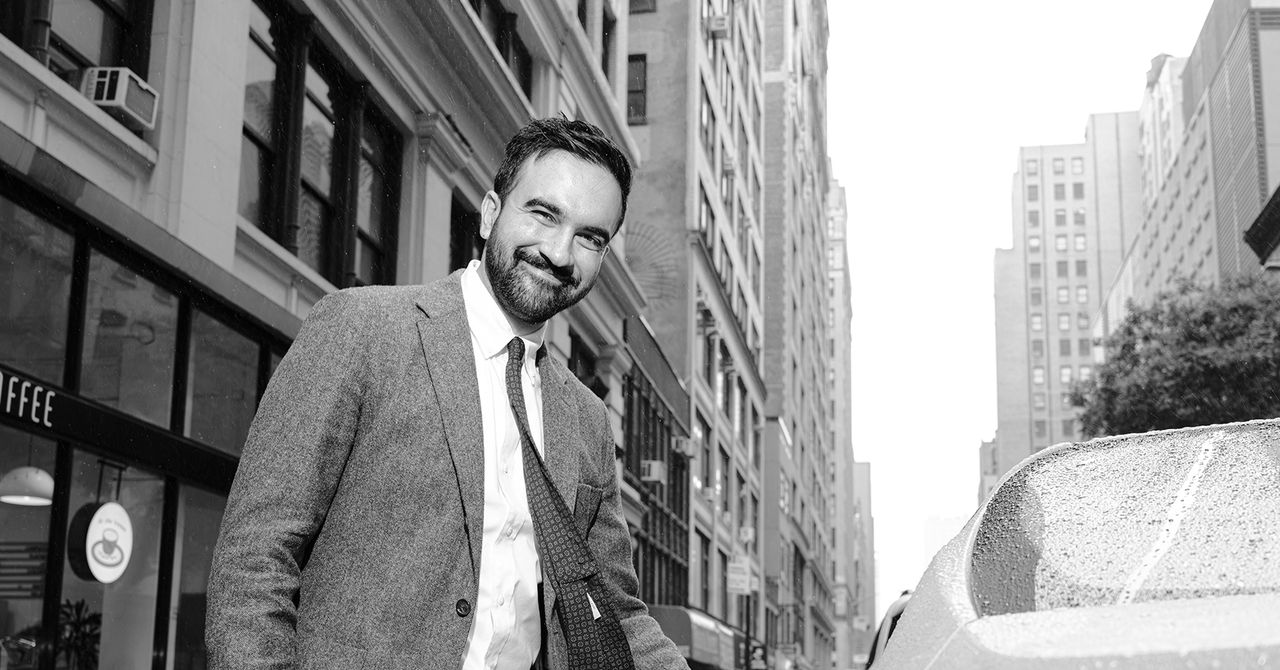Tech
Zohran Mamdani, the Internet’s Mayor

Zohran Mamdani is, quite literally, everywhere.
The 34-year-old New York state assemblyman, who in recent months has ascended from relative political anonymity to become the presumptive winner of New York City’s November mayoral race, has already graced the covers of Time, New York, Vanity Fair, and The Nation, among other publications. He’s sparred with newscasters on CNN and Fox News, riffed with Stephen Colbert, and bantered like his life depended on it with the hosts of The View.
Mamdani’s ubiquity didn’t start with print pages or broadcast interviews. Much of that conventional media exposure, and Mamdani’s growing celebrity, is a collective byproduct of one single element of his mayoral campaign: a really, really good social strategy. One of Mamdani’s first viral videos, a 2024 supercut of short conversations between the assemblyman and New York–based Trump voters, laid the groundwork for a subsequent mayoral campaign built on clever, conversational clips. See: Very Cold Mamdani, emerging from a polar plunge in the Atlantic Ocean with a vow to freeze rent on rent-stabilized apartments. See also: Sneakers Mamdani, walking the length of Manhattan to advocate for accessible politicians; Citi Bike Mamdani, responding to a bystander’s howl of “Communist” before pedaling off as cameras roll; or Red Rose Mamdani, spoofing The Bachelor while wooing New Yorkers with promises of an equitable future. Yes, the #ZaddyZohran TikTok hashtag is nearly as prolific as the candidate who inspires it.
But as Mamdani acknowledged during a recent sit-down at his campaign’s spartan Manhattan headquarters, his outsized ubiquity also has its downsides: There’s the ire of President Trump, who has denounced Mamdani as “a 100% Communist lunatic,” threatened to arrest him, and, should the front-runner topple Andrew Cuomo in November, deploy the National Guard to New York City. Then there’s the risk of violence against Mamdani or his campaign staff; it’s a concern that increased markedly following the recent assassination of far-right activist Charlie Kirk, and, for Mamdani, means “I’m never alone now.”
But for someone as everywhere as Mamdani, hunkering down in the secure confines of an office can only last so long. Forty-five minutes, to be exact, before our interview concludes and Mamdani (security detail in tow) gamely joins WIRED’s photographers on a bustling Manhattan street, posing inside a yellow cab and walking to and fro on the sidewalk. It would be an understatement to say that passersby took note. They did take selfies—at least five in fewer than 10 minutes. They also took campaign materials, seemingly so inspired by a mere glimpse of Zaddy Zohran that they were compelled to join his 80,000-strong army of volunteers. And, in typical New York fashion, they did all of this with no semblance of personal shame, screaming Mamdani’s name from the open windows of office towers and cars; hooting at him from across the street and down the block.
It remains to be seen whether Mamdani as mayor can satisfy these starstruck locals, along with his thousands of volunteers and hundreds of thousands of presumed voters—not to mention the many millions more following along online. For now, Mamdani is embracing the life of a newly minted internet darling. After one last wave has been proffered, to a particularly loud fan shouting from a window across the street, the candidate and his team duck back inside their nondescript office building. Up the elevators and, presumably, on to the next interview.
This interview has been edited for length and clarity.
Photograph: Ike Edeani
Tech
WIRED Roundup: DOGE Isn’t Dead, Facebook Dating Is Real, and Amazon’s AI Ambitions

Leah Feiger: So it’s a really good question actually, and it’s one that I’ve thought about for quite some time. I think if it’s not annoying, I want to read this quote from Scott Kupor, the director of OPM and the former managing partner at Andreessen Horowitz, to be clear, just to remind everyone where people are coming from in this current administration. He posted this on X late last month, and this was part of Reuter’s reporting. So he posts, “The truth is, DOGE may not have centralized leadership under USDS anymore, but the principles of DOGE remain alive and well, deregulation, eliminating fraud, waste and abuse, reshaping the federal workforce, et cetera, et cetera, et cetera.” Which is the exact same, the thing that they’ve been saying this entire time, but it’s all smoke and mirrors, right? It’s like, oh no, no, well, DOGE doesn’t exactly exist anymore. There’s no Elon Musk character leading it, which Elon Musk himself said on the podcast with Joe Rogan last month as well. He’s like, “Yeah, once I left, they weren’t able to pick on anyone, but don’t worry, DOGE is still there.” So it feels wild to watch people fall for this and go like, “DOGE is gone now.” And I’m like, they’re literally telling us that it’s not.
Zoë Schiffer: I think one thing that does feel honestly true is that it is harder and harder to differentiate where DOGE stops and the Trump administration begins because they have infiltrated so many different parts of government and the DOGE ethos, what you’re talking about, deregulation, cost cuttings, zero-based budgeting, those have really become kind of table stakes for the admin, right?
Leah Feiger: I think that’s such a good point. And honestly, by the end of Elon Musk’s reign, something that kept coming up wasn’t necessarily that the Trump administration didn’t agree with DOGE’s ethos at all. It was that they didn’t really agree with how Musk was going about it. They didn’t like that he was stepping on Treasury Secretary Scott Bessent and having fights outside of the Oval Office. That was bad optics and that also wasn’t helping the Trump administration even look like they were on top of it.
Tech
Horses, the Most Controversial Game of the Year, Doesn’t Live Up to the Hype

The debate over Horses’ delisting is emblematic of a bigger fight that’s taken place this year, when platforms such as Steam and Itch.io yanked down “NSFW” and “porn” games in July. Developers, players, and trade organizations have continued to be vocal about developers’ creative rights to make games that deal with adult content.
“Developers shouldn’t have to compromise their creative vision, but we also have to acknowledge that games exist within capitalist structures where access to platforms determines livelihood,” says Jakin Vela, executive director of the International Game Developers Association, a nonprofit supporting game developers. “The key is informed decision-making and understanding what each platform allows, what risks exist, and whether your artistic goals outweigh those risks.”
Still, Vela says, these removals have exposed the fragility of developers’ economic security. “We should be concerned whenever a system allows a creator’s livelihood to be cut off without transparency or recourse,” he says. The video game industry is highly consolidated, with a handful of platforms controlling access to the vast majority of players. “That imbalance creates a structural issue, not necessarily because platforms enforce rules, but because there are so few viable alternatives.”
Santa Ragione’s future should not hinge on its ability to exist on Steam or any other platform. A bad project should not spell the end of a developer who is, for all the criticisms I have of its game, trying to say something. That part of this story may still yet have a happy, or at least a survivable, ending. The Streisand effect is paying off for Horses. On the digital distribution platform GOG, where it’s still available, the game is a top-seller.
Horses needs to be defended against censorship. It is also a bad game that should be examined as such. But while the conversation around Horses is still stalling out about why the game is allowed to exist, or how it’s not that offensive, the better question is why we really care about it at all—and why, as players, we feel so reluctant to talk about its failings like any other piece of media.
Tech
Silk & Snow Seemingly Cannot Miss—So Don’t Skip This Sale That Ends in 2 Days

I try to test every individual product critically and neutrally, but sometimes a brand comes along that seemingly cannot miss. We have liked everything we’ve tried from Silk & Snow, and right now the company is hosting a Cyber Week Sale that runs through December 7. You can save on some of our favorite bed frames and mattresses that we’ve tested long-term in our own homes, and if you prefer to browse on your own, the sale offers up to 35 percent off site-wide. I’ve rounded up the highlights on WIRED-tested gear below.
WIRED Featured Deals:
Silk & Snow Bed Frame With Drawer Storage for $560 ($140 off)
In our Bed Frame Buying Guide, I say that Silk & Snow could charge more for this bed frame—but right now, it’s 20 percent off. Assembly is a little bit annoying. But the fabric-covered headboard is gorgeous, and the frame is sturdy. My favorite part is the drawer cleverly concealed at the foot of the frame, with its two partitions and its magnetic closure. It does feel a little jarring if you open and close the drawer while your partner is in bed, but I like having extra storage in my room, especially since this frame is too low to the ground to allow for stashing things under it.
Silk & Snow S&S Organic Mattress for $765 ($235 off)
The S&S Organic Mattress is the best organic latex mattress. It’s very soft and offers a lot of pressure relief and support, but the responsive material means it’s better suited to solo sleepers than it is to couples. It feels like a soft, dense marshmallow, per our sleep reviewer Julia Forbes, who advises using lightweight blankets and cooling sheets if you’re a hot sleeper and also raved about the lengthy year-long sleep trial. As part of the Cyber Week sale, you can choose between a free sleep bundle (with a sheet set, a duvet, two microfiber pillows, and a mattress protector) or you can opt out of the bundle to get an extra 10 percent off your mattress.
Silk & Snow Wooden Bed Frame for $1,040 ($260 off)
This bed frame from Silk & Snow made our list of the best Thuma dupes. The Japanese joinery platform frame comes in your choice of natural rubber wood or cortado acacia wood, each in two different finishes. Assembly is pretty easy and doesn’t require any special tools, and you’ll get a robust five-year warranty. The resulting frame is sturdy and gorgeous, though we recommend having a helper around if you need to disassemble the frame to protect the finish on the wood.
Power up with unlimited access to WIRED. Get best-in-class reporting and exclusive subscriber content that’s too important to ignore. Subscribe Today.
-

 Tech6 days ago
Tech6 days agoGet Your Steps In From Your Home Office With This Walking Pad—On Sale This Week
-

 Sports5 days ago
Sports5 days agoIndia Triumphs Over South Africa in First ODI Thanks to Kohli’s Heroics – SUCH TV
-

 Fashion5 days ago
Fashion5 days agoResults are in: US Black Friday store visits down, e-visits up, apparel shines
-

 Entertainment5 days ago
Entertainment5 days agoSadie Sink talks about the future of Max in ‘Stranger Things’
-

 Politics5 days ago
Politics5 days agoElon Musk reveals partner’s half-Indian roots, son’s middle name ‘Sekhar’
-

 Tech5 days ago
Tech5 days agoPrague’s City Center Sparkles, Buzzes, and Burns at the Signal Festival
-

 Sports5 days ago
Sports5 days agoBroncos secure thrilling OT victory over Commanders behind clutch performances
-

 Entertainment5 days ago
Entertainment5 days agoNatalia Dyer explains Nancy Wheeler’s key blunder in Stranger Things 5






















